While the Amazon is being whittled away on all sides by logging, agriculture, roads, cattle ranching, mining, oil and gas exploration, today’s announcement of a new monkey species proves that the world’s greatest tropical rainforest still has many surprises to reveal. Scientists with the National University of Colombia and support from Conservation International (CI) have announced the discovery of a new monkey in the journal Primate Conservation on the Colombian border with Peru and Ecuador. The new species is a titi monkey, dubbed the Caquetá titi (Callicebus caquetensis). However, the announcement comes with deep concern as researchers say it is likely the new species is already Critically Endangered due to a small population living in an area undergoing rapid deforestation for agriculture.
Discovered by Thomas Defler, Marta Bueno, and Javier Garcia during an expedition to the Department of Caquetá in Colombia in 2008, the find was a culmination of data collected over 30 years ago when Martin Moynihan, expert in animal behavior, recorded observations of a mysterious titi. However, researchers were forced to avoid the area for years due to insurgent activity. When the area become safe to visit again, Garcia, a native of Caquetá, searched for Moynihan’s mystery monkey and discovered 13 populations of a new species.
“This discovery is extremely exciting because we had heard about this animal, but for a long time we could not confirm if it was different from other titis. We now know that this is a unique species, and it shows the rich diversity of life that is still to be discovered in the Amazon,” Defler said in a press release.
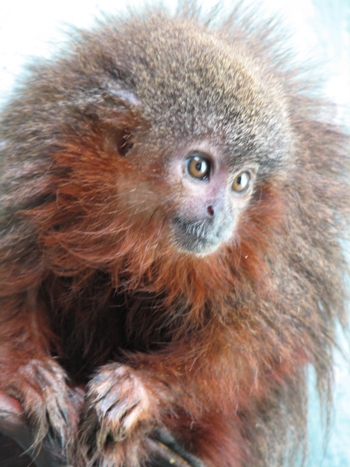 The new species of titi monkey: the Caquetá titi ( Callicebus caquetensis), discovered in the Colombian Amazon. Photo by: Javier Garcia. |
About the size of a cat, the new monkey lacks the white bar on its forehead common to many closely-related titis. Titi monkeys are unique in that probably all species are monogamous, forming lifelong pair-bonds. Partners give birth to one offspring a year, and force the baby from last year to become independent at that point. They also employ highly complex call to communicate.
The researchers believe that the Caquetá titi is on the edge of extinction, estimated that less than 250 individuals survive in the world. Their habitat is being increasingly fragmented by agriculture, hemming the monkeys in by savannah and barbed wire.
“This discovery is particularly important because it reminds us that we should celebrate the diversity of earth but also we must take action now to preserve it,” José Vicente Rodríguez, head of science at Conservation International in Colombia and president of the Colombia Association of Zoology, said in a press release.
“When world leaders meet later this year in Japan for the Convention on Biological Diversity, they must commit to the creation of many more protected areas if we want to ensure the survival of threatened creatures like this in the Amazon and around the world,” he adds.
In recent years researchers have discovered a number of new monkeys. Last year reasearchers announced a new subspecies of tamarin: Mura’s saddleback tamarin (Saguinus fuscicollis mura) found the Brazilian Amazon. In 2008 researchers found a new species of uakari monkey, named the Aracá uakari (Cacajao ayresii) after it was killed by the Yanomamo tribe also in Brazil.
New monkeys have also been discovered in Africa recently. In 2007 researchers confirmed that a population of what was thought to be Grey-cheeked mangabeys was actually a new species, now called Uganda mangabey (Lophocebus ugandae). In 2005 researchers found an even bigger surprise in Africa. A new monkey that belongs in its own genus: the Critically Endangered kipunji (Rungwecebus kipunji). The kipunji, which is among the top 25 most endangered primates in the world, was the first new monkey genus to be described since 1923.
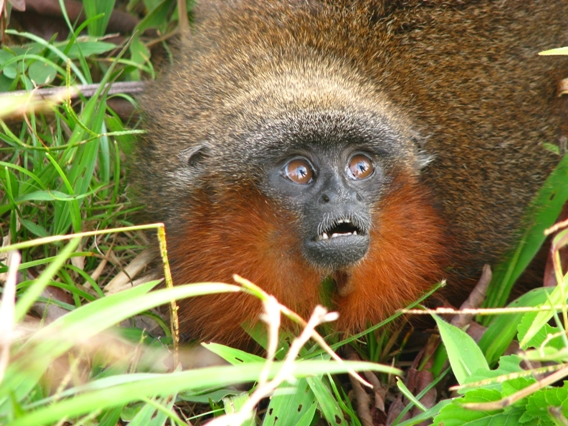
The Caquetá titi ( Callicebus caquetensis). Photo by: Javier Garcia.
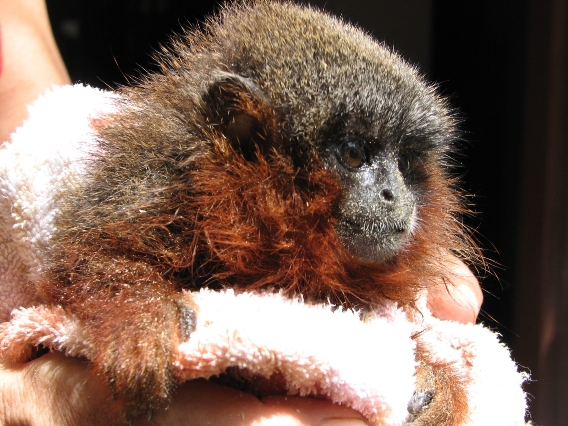
The Caquetá titi ( Callicebus caquetensis). Photo by: Javier Garcia.
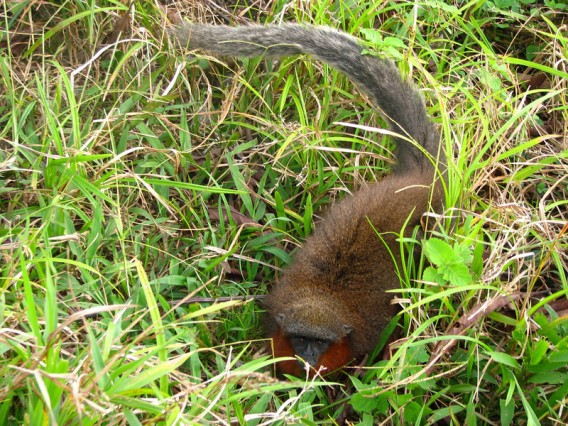
The Caquetá titi ( Callicebus caquetensis). Photo by: Javier Garcia.
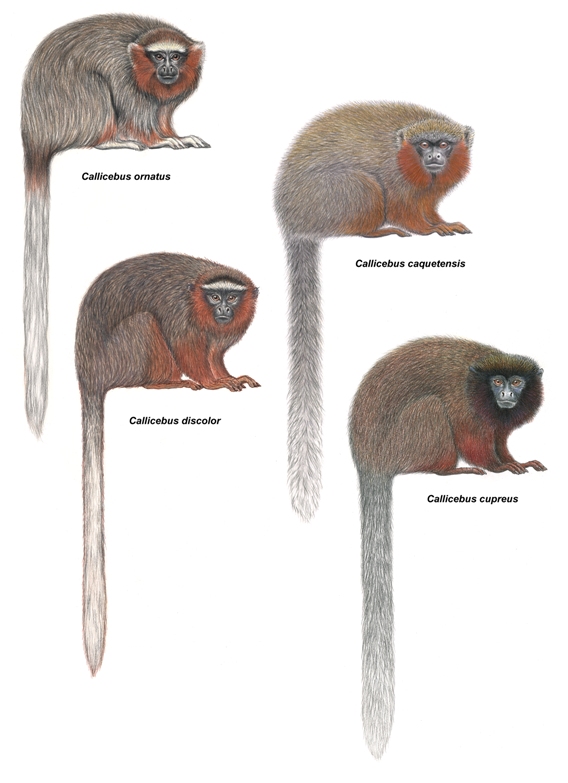
The Caquetá titi ( Callicebus caquetensis) compared to closely related species. CI illustration by Stephen Nash.
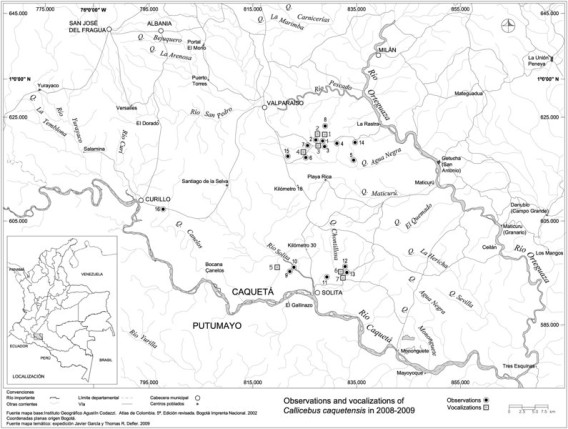
Map of the area where a new species of titi monkey was found in Colombia by Drs Thomas Defler, Marta Bueno and Javier García with support from Conservation International. Illustration by Thomas Defler. Click to enlarge.
Related articles
More research and conservation efforts needed to save Colombia’s monkeys
(03/29/2010) Approximately thirty monkey species inhabit the tropical forests of Colombia with at least five found no-where else in the world. A new review appearing the open access journal Tropical Conservation Science of Colombia’s primates finds that a number of these species, including some greatly endangered species, have been neglected by scientists. The researchers looked at over 3,500 studies covering over a century of research by primatologists.
Humans push half of the world’s primates toward extinction, lemurs in particular trouble
(02/18/2010) Of the known 634 primate species in the world 48 percent are currently threatened with extinction, making mankind’s closes relatives one of the most endangered animal groups in the world. In order to bring awareness to the desperate state of primates, a new report by the International Union for the Conservation of Nature highlights twenty-five primates in the most need of rapid conservation action. Compiled by 85 experts the report, entitled Primates in Peril: The World’s 25 Most Endangered Primates, 2008–2010, includes six primates from Africa, eleven from Asia, three from Central and South America, and five from the island of Madagascar.
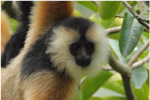
(09/24/2009) There are 200 Tonkin snub-nosed monkeys left in the world. The cao vit gibbon, however, is even worse off with only 110 individuals remaining, giving it the dubious honor of being the second most endangered primate in the world (the closely-related Hainan gibbon with only 17 individuals is likely number one). Both of these species—the cao vit gibbon and Tonkin snub nosed monkey—have received good news recently as new reserves in China and Vietnam have been created in part to aid their survival.
Tiny monkey species discovered in the Amazon rainforest

(07/07/2009) A new species of monkey has been discovered in the Brazilian Amazon, reports the Wildlife Conservation Society. The monkey, a type of saddleback tamarin, has been named Mura’s saddleback tamarin (Saguinus fuscicollis mura) after the Mura Indians, the Amerindian ethnic group that lives in the Purus and Madeira river basins where the monkey occurs.
TV footage leads to discovery of strange and rare monkey
(12/04/2008) After showing archival TV footage of a critically endangered species of primate to local villagers, conservationists have discovered a previously unknown population of the Tonkin snub-nosed monkey in a remote forested area of northern Vietnam. The find the offers new hope for the species, which is down to 200 individuals in two of Vietnam’s northern-most provinces — Tuyen Quang and Ha Giang.
Newly discovered monkey is critically endangered by logging, poaching
(07/28/2008) A newly discovered species of monkey may already be threatened with extinction, according to a study published in the journal Oryx.
New uakari monkey discovered in the Amazon rainforest
(02/05/2008) A previously unknown species of uakari monkey was discovered in the Brazilian Amazon, reports National Geographic News. The primate was identified after it was killed by Yanomamo Indians near the Brazil-Venezuela border.
